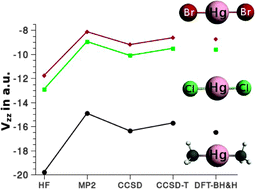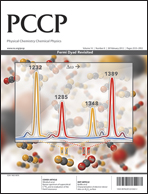Fully relativistic coupled cluster and DFT study of electric field gradients at Hg in 199Hg compounds†
Abstract
We investigate the magnitude and interplay of relativistic and electron correlation effects on the electric field gradient (EFG) at the position of Hg in linear and bent HgL2 (L = CH3, Cl, Br, I) and trigonal planar [HgCl3]− compounds using four-component relativistic Dirac–Coulomb (DC) and non-relativistic (NR) calculations at the Hartree–Fock (HF), DFT, MP2 and coupled cluster (CC) levels. The relativistic and electron correlation contributions to EFG have opposite signs and are not additive, demonstrating the importance of taking into account relativistic and electron correlation contributions on an equal footing. DC-MP2 overestimates the electron correlation correction by 0.48–0.56 a.u. for Hg-halides and by 0.8 a.u. for Hg(CH3)2, respectively, while DC-CCSD underestimates the correlation correction by 0.57–0.66 a.u. compared to the reference DC-CCSD-T data. EFGs obtained at the DC-DFT level vary considerably with the functional; DC-CAMB3LYP and DC-BH&H reproduce DC-CCSD-T results within 0.08–0.24 a.u. (1%–3%) for Hg(CH3)2 and Hg-halides, respectively. An updated value of the nuclear quadrupole moment of the I = 5/2 excited state of 199Hg, Q(199Hg) = 0.675(12) b is derived from the literature. This value compares well with that derived from our calculated EFG at the DC-CCSD-T level and the experimental data for Hg(CH3)2; Q(199Hg) = 0.650 b.


 Please wait while we load your content...
Please wait while we load your content...